To view this content, you must be a member of the Rose City Review Patreon
Already a qualifying Patreon member? Refresh to access this content.
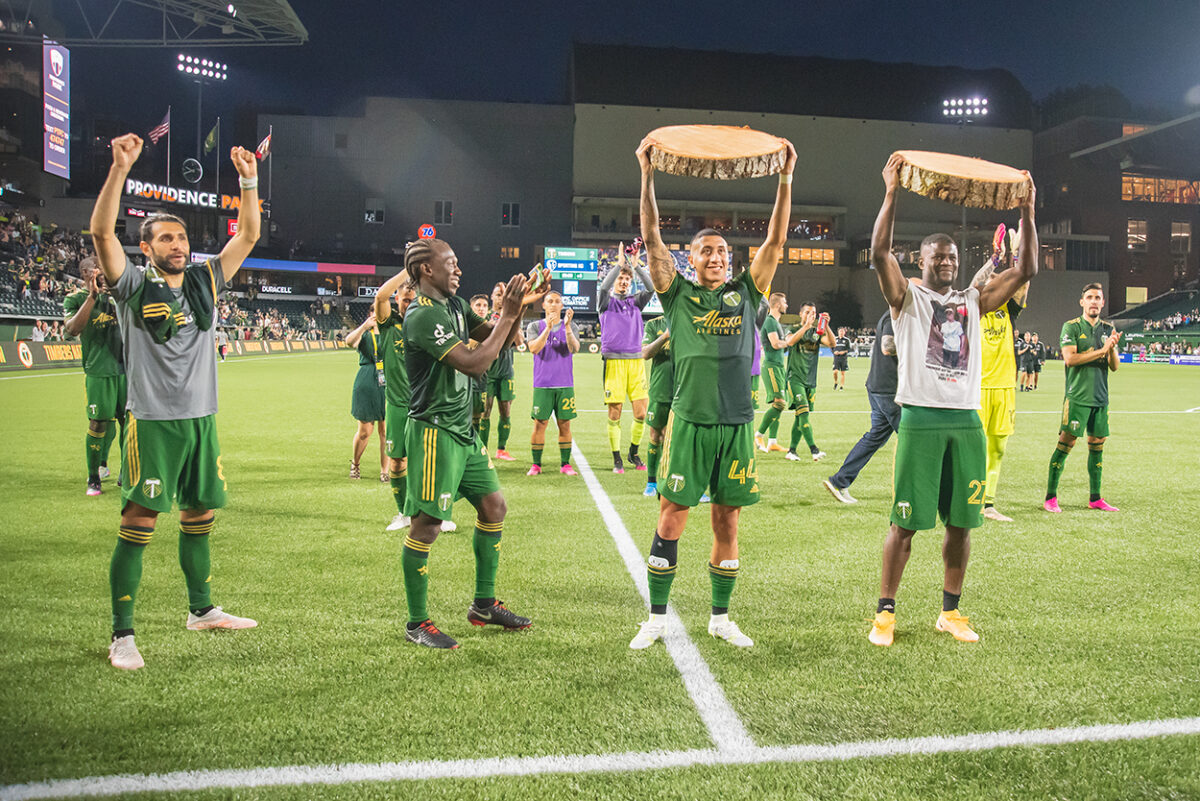
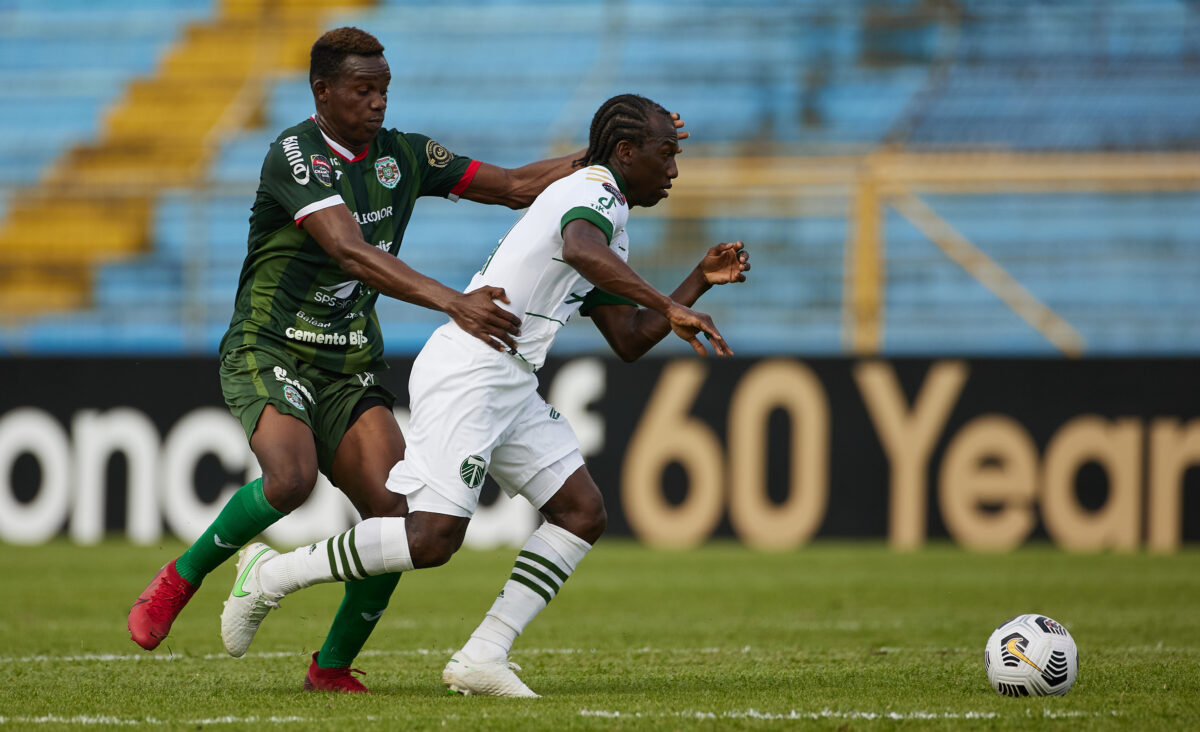
Portland coach Giovanni Savarese understood the task at hand before the Timbers even touched down in San Pedro Sula, Honduras, for the first leg of their CONCACAF Champions League series against CD Marathón.
He knew that Marathón, a team that’s won just two of its first ten league games in the clausura season, wanted to make the most of a fresh start in a new competition. That they would be comfortable sitting back before springing into attack.
Earlier in the week, Savarese talked about the directness and individual talent Marathón possessed, and acknowledged that the opening game would be a good time for his team to test their mettle, especially with the ball.
In many ways, that’s exactly what played out on Tuesday in Portland’s 2–2 draw at the Estadio Olimpico Metropolitano. The Timbers finished the game with 58% of the possession, outshot Marathón 16–12, and completed 107 more passes.
In their first competitive game since the first round of the 2020 MLS Cup Playoffs, Portland was given both the ball and the onus to do something with it against a compact opponent. While known more as a counter-attacking team in the Savarese era, the Timbers will face games where they need to break teams down with the ball. A season ago, the team showed progress in that facet of their game––hey, fewer hopeful crosses is always a good thing––and received an early opportunity to test themselves in possessional play this season.
“I thought it was very competitive, and I thought that we did a lot of very good things, especially in the first half,” Savarese said. “We created chances. Unfortunately, we couldn’t capitalize a little bit more on the chances we created.”
The Timbers started the match on the front foot and found themselves with multiple scoring opportunities early. Yimmi Chará continuously attacked Marathón left back Luis Vega down the right wing, which created danger right away. Winger Dairon Asprilla later bodied off a defender to get a shot off in the box that he dragged wide by a good margin. In the 27th minute, midfielder Eryk Williamson nearly pulled off a moment of magic with a side-footed shot that keeper Denovan Torres did well to save.
Then, in the 35th minute, Portland found its breakthrough when striker Felipe Mora brought down the ball in the box and squeezed the ensuing shot under Torres’ outstretched right hand.
The goal, while not flashy, perfectly exemplified the Timbers’ effective possession play. With the team in their attacking third, right back Josecarlos Van Rankin slowly made his way from the right side of the field to the left half-space where he received the ball from left back Claudio Bravo, beat two defenders, and chipped a ball with his left foot to Mora, who found the back of the net.
Van Rankin’s addition into the attack provided the Timbers with an offensive wrinkle in possession, which helped them break down coach Hector Vargas’ compact side. The right back’s presence in that left half-space drew Marathón center back Mathías Techera away from Mora for a split-second, which allowed the striker to control the ball and get a shot off. While there are potential drawbacks to that type of cross-field run––say the ball turns over quickly and that entire space is vacated––the addition of Van Rankin into the attack proved crucial in Portland’s first goal of 2021.
Savarese also asked Mora to drop into midfield from time to time to help the Timbers create numerical advantages in central areas while in possession. With wingers Yimmi Chará and Asprilla tasked with stretching Marathón’s defense, Mora had plenty of room to work with when he dropped back and combined with midfielders Diego Valeri or Eryk Williamson. While Mora seemed to tire near the end of 90 minutes, his ability to drop into midfield and also finish opportunities in attack will certainly prove useful for Portland this season.
Savarese said the team went into the game with the aforementioned goal of stretching Marathón out, especially between midfield and defense, to create more space in possession. He felt like the team did that, especially early.
“I think that the balance that we have with Diego Chará and Eryk [Williamson] in the middle was very, very good,” Savarese said. “The defense handled the long balls really well, and going forward we were patient enough to find the right moment to keep the ball or to get behind to create opportunities.”
Valeri thrived in the additional space created in midfield. The Timbers star scored the (own) goal of the game from a free-kick taken from yards behind the box and constantly popped up in vacant midfield spaces. The Argentinian played a large role in both finding and creating the “right attacking moments” that Savarese mentioned.
“He was phenomenal today,” Savarese said. “He was very active and found a lot of good spaces to give us the chance to be able to be vertical.”
While Portland looked effective in possession through large stretches of play, it wasn’t all perfect. The Timbers failed to capitalize on multiple golden opportunities. In the 57th minute, Yimmi Chará had a great opportunity on a corner kick that fell into his path in the box with nobody around him, but he didn’t put enough power on the ball and shot it straight at Torres.
Marathón’s deeper formation also enticed Portland to creep further up the field, which opened up new spaces for the very direct Central American side to attack through. That’s what happened in the 68th minute when midfielder Kervin Arriaga found plenty of room between the Timbers’ lines to drive into before delivering a well-weighted pass to forward Marlon Ramírez who leveled the score 2–2.
“Arriaga found moments to dribble and become a little more dangerous,” Savarese said. “Then they found some corners and more dangerous crosses.”
On Tuesday, Timbers fans got their first look at what Savarese wants his team to look like when forced to play with the ball. In just under a week, some will see it first hand when the team returns to Portland with a 2–2 result to defend and everything to play for.
“We’re not satisfied with this result,” Savarese said, “but scoring two goals away is very important.”
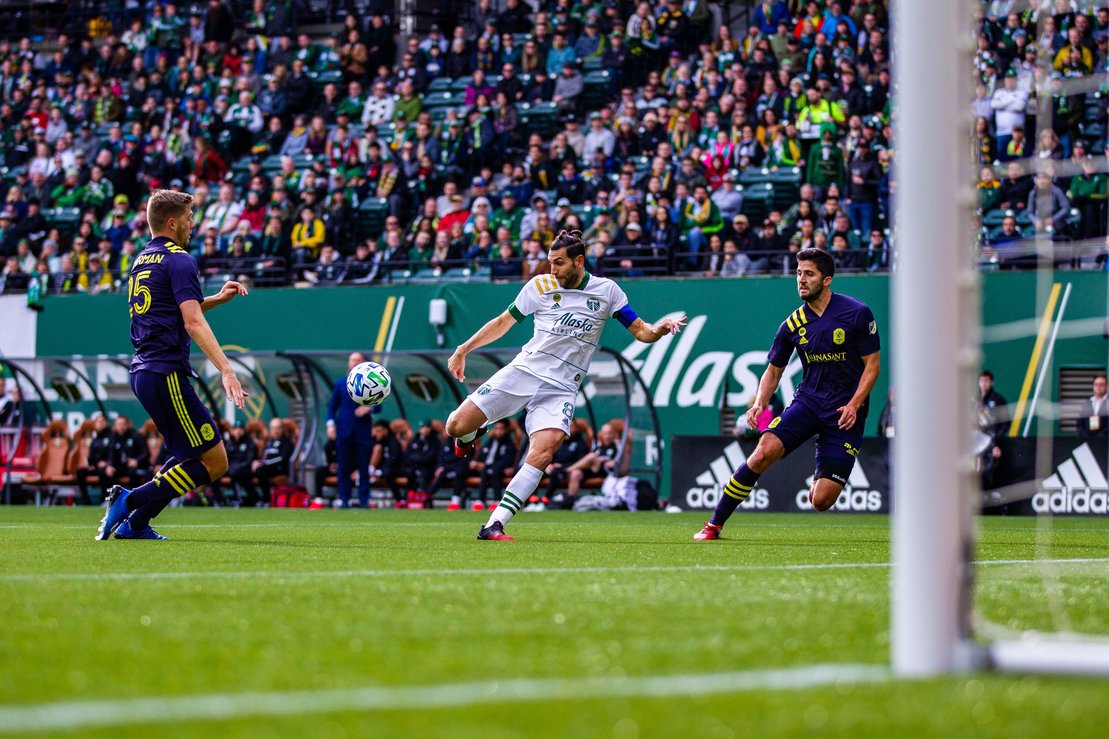
Players have been tested, teams are beginning to filter into Orlando, and we are just over a week away from kickoff of the MLS is Back Tournament.
Nearly four months have elapsed since LAFC and the Philadelphia Union played to a 3-3 draw back in early March. And before Inter Miami and Orlando City take to the field, Rose City Review talked to Joe Lowery—who currently co-hosts the MLS Assist Podcast—about the Timbers’ potent attack, defensive question marks, and the many ways in which they could create chaos in Orlando.
(The conversation below has been edited for clarity and length)
Kyle Pinnell: It’s been about a week since the draw. What were your initial thoughts on Group F, and more specifically, the Portland Timbers?
Joe Lowery: It’s going to be really interesting in terms of the on-field stuff, right? It’s going to be interesting to see how teams take things and how coaches want to approach the group stage which is actually worth points long term. There are a lot of questions as far as that goes, but looking specifically at Group F, there are a lot of unknowns in that group, I think.
You have LAFC, and we kind of know what we are going to get from them, although it will be interesting with the addition of Andy Najar to see how that is going to change things if he gets minutes. With the Timbers, Houston, and the Galaxy, to be honest with you, those teams all have large question marks around them.
The Timbers, I don’t think they defended well. Their defensive block, which is really really important to how they want to play, wasn’t very solid. The Galaxy are still trying to figure out how to attack with Chicharito and Cristian Pavón, and then the Houston Dynamo are right in this revamp under Tab Ramos, and they’ve only had two games to sort that out—those games were without Alberth Elis. We don’t really know what the Dynamo look like, we know what the Timbers want to be, and we know what the Galaxy want to be, but they aren’t there yet either. There are a lot of unknowns, especially after LAFC, in that group.
Pinnell: Yeah. We know how the Timbers want to play, they want to press and play a beautiful style of soccer, but that has turned into counter-attacking, playing long balls over the top, and hoping for interesting results. Over the first few games of the season, what have you seen when you watched the Timbers?
Lowery: With the Timbers, it’s interesting to me because every coach says that they are going to play with the ball, every coach wants to have the ball for the most part. The Timbers, in a way, still have the pieces to do that. They have two of the highest skilled on-ball players in the league with [Diego] Valeri and Sebastián Blanco. You think about having those two guys as attacking midfielders in a possession scheme, that sounds pretty nice, I love that idea. You have Diego Chará who is nice on the ball as well and he can do things in possession as a number six.
They have options here in certain spots, but not all the way around, and I think that is the problem here. They have guys along the backline, specifically center backs, that I don’t think are great with the ball. I’ll have to watch them more, but they never stood out to me as being these offensive powerhouses, which makes it difficult to keep possession a lot of the time.
Whether it’s the center backs or it is the fullbacks or the team not having that cohesion in possession, so often I think they revert to what seems to be their DNA for one reason or another. That’s sit in a defensive pocket, press occasionally, and then win the ball and have Diego Valeri and Sebastian Blanco be the playmakers on the fast break. They can do more things than that. They can hold the ball and play through those guys in possession, but for some reason, they seem to continue to go back to that counter-attacking style, which is fine, it’s a totally viable approach, it just seems like they are lacking a little bit in terms of their tactical identity with the ball on the field.
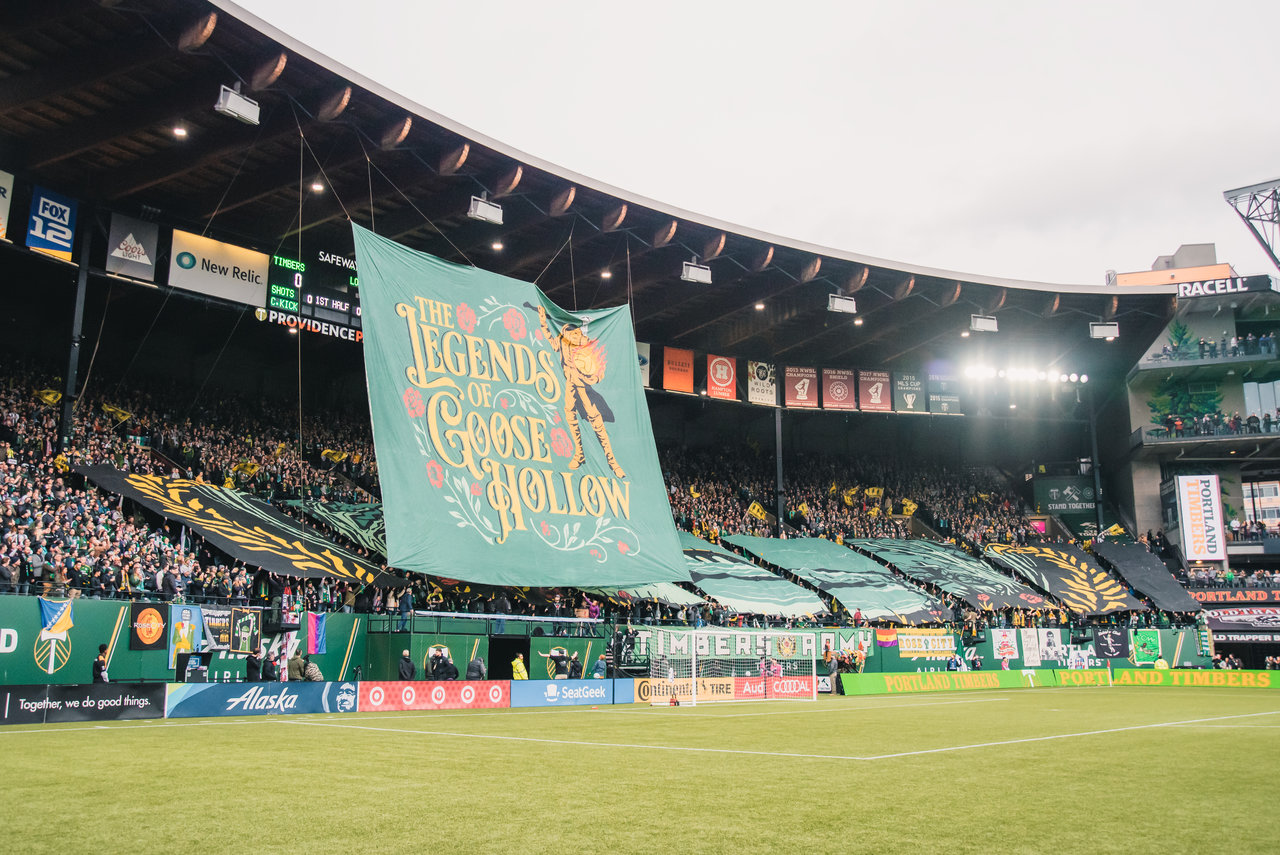
Pinnell: Going back to what you’ve seen out of the Timbers, when you watch them in Orlando, what will you have to see change to make it seem like the team is going in the right direction or that you’re seeing positive change?
Lowery: I think with the Timbers, seeing them shore up their defensive block would be big. Because I don’t think they’re ever going to be the team that has the ball for 60 percent of the game, or at least not in most games. When you’re not that team, your defensive block is really important because you’re playing against the ball for a lot of the game.
Going back to LAFC as an example, imagining a matchup between those two teams on the field, right now I don’t have a lot of confidence in the Timbers’ defensive shape to be able to contain a possessive team like that. But if they come in, they understand their roles in a defensive block—if they’re in a 4-4-2 or 4-5-1, whatever it is—they understand their assignments, where they need to be, and how they’re going to shift to deny penetration and force the ball wide if that’s what [head coach] Gio [Savarese] wants to do. They’re going to need to know when to trap, when not to trap, and when to step versus when not to step. If they can work that out, and if they have worked that out in this last three-month break, that’s going to be a great asset for them. That takes the Timbers from being a bad team in my mind to being a dangerous team that you don’t really want to play.
Pinnell: Looking at Diego Chará, he sometimes drops into the backline to help the team build possession and carry the ball into the midfield. How do you see the Timbers getting the ball from the backline, which you’ve said yourself doesn’t have any players excel at playing out of the back, into the midfield where they can be more dangerous?
Lowery: Having [Diego] Chará drop a little bit is a look that I actually really like with the Timbers. Maybe it’s Valeri, maybe it’s Blanco, maybe it’s Paredes dropping in a little bit; it allows the midfielders to get touches on the ball and distribute, which I appreciate. You just find the balance with that because you also want Valeri and Blanco higher up the field as well. Maybe you bring one of them down deeper into midfielder and you have the other one staying a little higher, that’s fine. I like that rotation with [Diego] Chará dropping from his six spot in between the center backs, moving the center backs out wide, pushing the full backs a little higher, and then you have Valeri and Blanco in those interior channels or in the middle of the field.
Then you have Yimmi Chará or whoever else is playing up front, that allows you to get those guys touches off of passes from Valeri and Blanco. Moving [Diego] Chará deeper I actually think is a pretty sustainable and successful look for the Timbers.
Pinnell: Now, when you observe the roster as a whole, who are some important players that you will be keeping an eye on?
Lowery: I want to see if/when/where Jeremy Ebobisse plays. I don’t think anybody really knows where he is going to play. I think that he should play as a [No.] 9 or as part of a front two, but that can be difficult with needing to give Valeri some touches up top, or how do you defend as part of a front line in a defensive block. I want to see where Ebobisse factors in, because I think he has something to bring to the table that he hasn’t had the chance to show for the Timbers.
Outside of that, I want to see more from Paredes as well in midfield. He’s a guy who is the unsung hero of that midfield in a lot of ways. [Diego] Chará gets a lot of headlines, and then Valeri and Blanco get the rest, so it’s a little challenging to know exactly what impact he’s going to have in this tournament. I like him as a player; I want to see more of him and focus on him more in that Timbers midfield. So Ebobisse and Paredes are the two guys for me that I am curious to watch with a more analytical eye on this tournament.
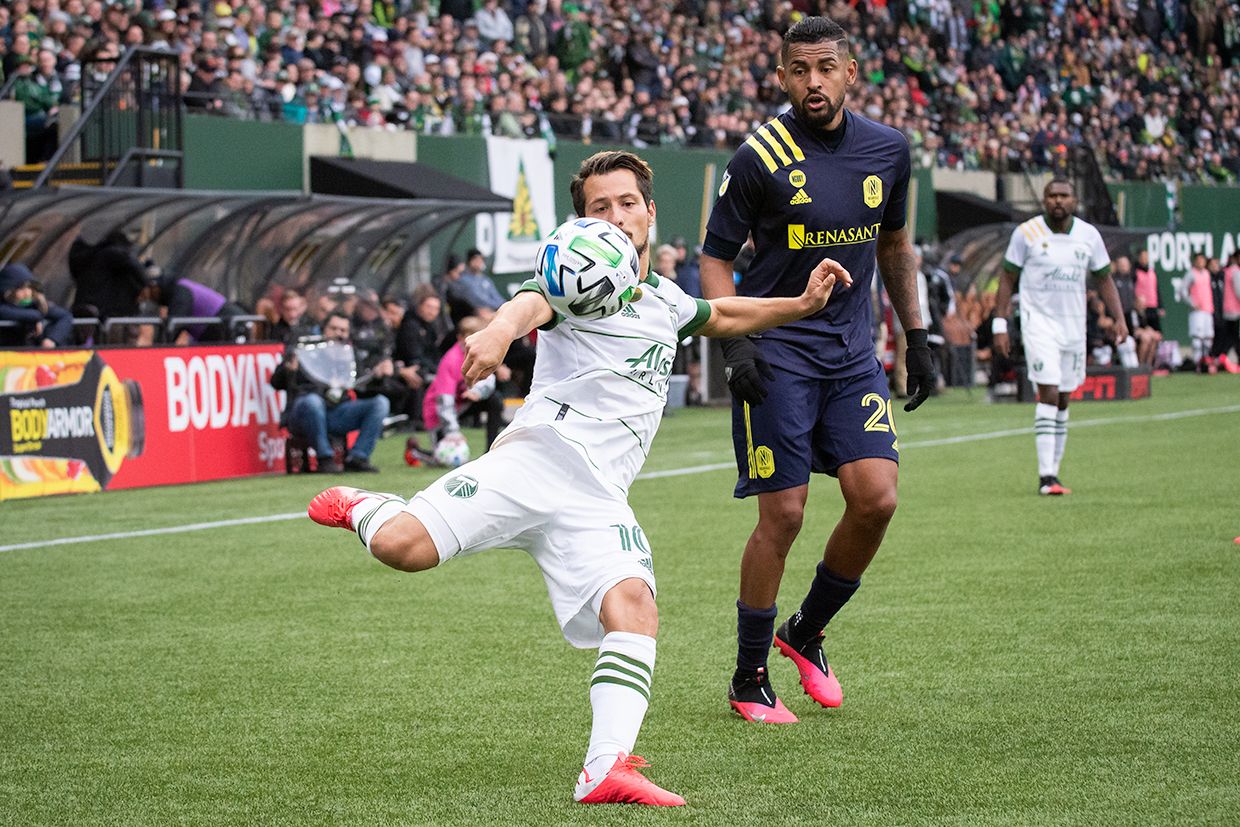
Pinnell: We started our conversation by talking about Group F as a whole, and honestly, the two teams that advance from the group could be a toss-up. With every team having questions, it might come down to which team has the most tactically adept coach who can tinker enough to find that formula to get them through the group. What coach do you think gives his team a distinct advantage for that second spot?
Lowery: So far, Barros Schelotto has been very predictable with how he plays, getting crosses into the box early and often throughout games. I think that unless we have a come-to-Jesus moment there with Barros Schelotto, then we’re going to see the same thing which is fairly predictable in a lot of ways.
Tab Ramos, I just straight up don’t know. Houston’s roster I don’t think is as talented as the Galaxy’s, maybe more similar to the Timbers in that regard. And with Gio Savarese, they’ve got the MLS Cup appearance, sure, but I’m not necessarily convinced that the Timbers are the finished product right now either. I’m not sure whether one coach has the tactical edge over another, to be quite honest with you.
Outside of Bob Bradley—I think he’s the number one guy in this group if we’re looking at just coaches. In terms of talent, though, if the Galaxy don’t advance from this group, and they actually try because we don’t know how the on-field quality is going to be, with Cristian Pavon especially—who I think is right up there with Carlos Vela in terms of best player in MLS, I think we’ll see that if we get a season this year—if they don’t make it out of this group, that’s going to be a little more unfortunate for them than it is for the Timbers or Dynamo. But as far as coaches go, I think it’s pretty even.
Pinnell: I agree, Bob Bradley definitely seems to be a level above most other coaches in this league. In an article that I recently published, I mentioned how the Timbers might be able to exploit space between lines. In a tournament like this, how do you think that the team could create that space?
Lowery: I think first of all that LAFC and Houston will open themselves up, which is good for a team like Portland because they want to attack into that open space. Looking at the Galaxy, that’s a different question. A lot of times they are going to get forward just because of the roster they have. They have the attacking talent, so it would be ridiculous for them not to get forward.
Still though, the Galaxy don’t play the same way that LAFC do or that Tab Ramos wants to do with Houston. So against a team like the Galaxy, they’re going to have to have possession a little bit more. They’re going to have to rely on their playmakers to get balls in from the backline or from Diego Chará, and then allow Diego Valeri’s off-ball movement, which is very very good, and have that captain them to better possession results. They have the tools in possession, and in the attack especially.
Getting the ball to Diego Valeri is one thing, but once they get the ball there, if they can get the ball there, then you are really cooking with something. If Valeri and Blanco can get on the ball in dangerous spots and get the ball to those spots in the first place, then the Timbers can pose a real threat with the ball against a team like LA. Creating and exploiting space in possession is going to be the thing for them, and I really do think that it comes down to how well their playmakers can get into spots and then distribute from there.
The rest of our conversation with Lowery is available in audio format for our $10 Patrons. You can find it under the “Patreon” tab on our website.
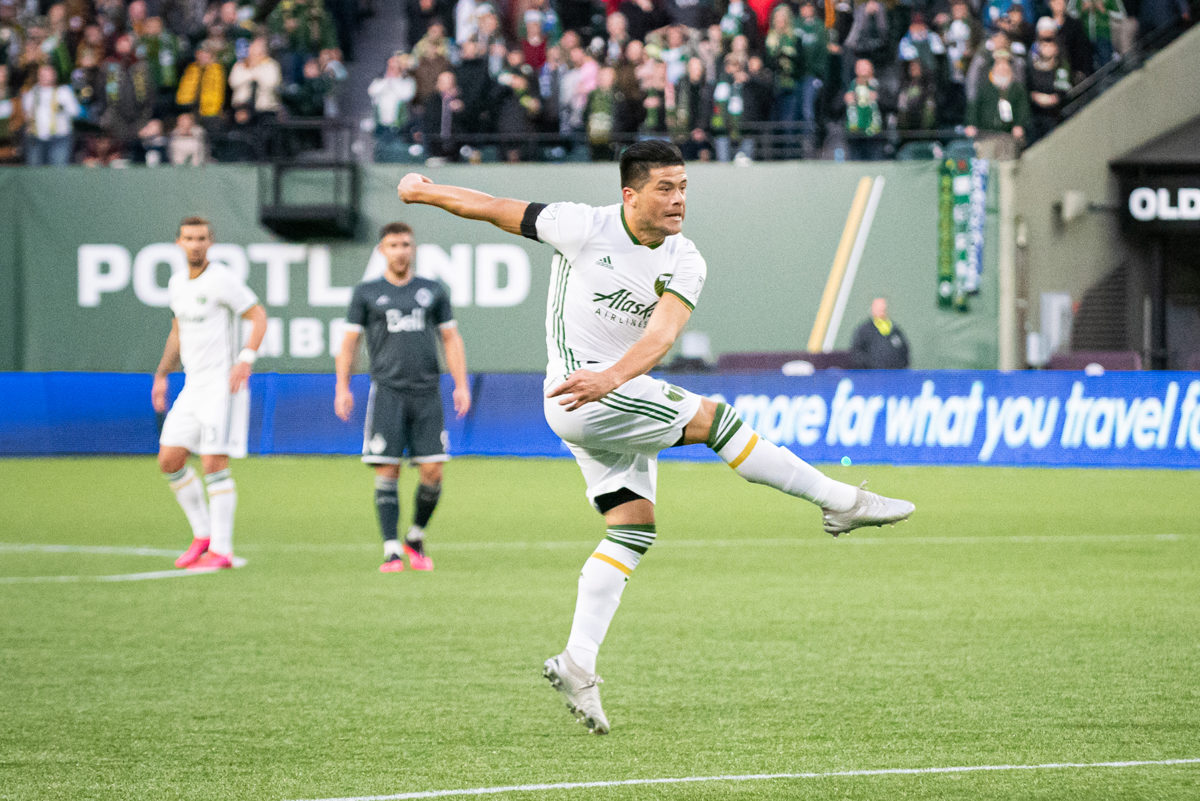
An already tough start to the season gets even tougher as the Portland Timbers prepare to deal with the lengthy absence of starting right back, Jorge Moreira.
ESPN’s Taylor Twellman broke the news of a potential long-term injury on Saturday afternoon, and Timbers.com writer, Richard Farley, later shared that the Timbers believe Moreira could have a partial meniscus tear in his left knee that requires surgery.
There have been no reports as to how long a potential surgery would sideline the Paraguayan, and with his loan from River Plate expiring in June, it’s a devastating blow for both the player and the organization.
But injuries happen in sports, and there’s nothing that the Timbers can do other than continue forward. What Moreira brings to the team is difficult to replace, but adjustments will have to be made. However, before looking at how the Timbers can move forward, it’s important to understand what Moreira brought to the team.
What the Timbers will be missing
Anytime an MLS side signs an experienced player from South America, especially from teams such as Boca Juniors or River Plate, they expect a talented player that can come in and contribute right away. A season ago, the Timbers needed a starting-caliber right back, and they found their guy in Moreira—a player with 57 starts for River Plate under his belt.
The 30-year old plays a huge role in the Timbers’ attack, often tasked with making overlapping runs into the final third, sending in crosses for strikers in the box, and, if necessary, using his speed to track back and win the ball back in defense.
When Portland plays out of the back, Moreira’s job is straightforward: find a way to beat the first line of defense. In the clip above, Moreira does a good job of beating Minnesota United’s initial pressure before finding Sebastian Blanco with plenty of room to exploit down the left wing. By beating that first line of defense, the Timbers create advantages in midfield that they hope to exploit.

Sometimes, defenses can’t stop him, and when this happens Moreira is more than happy to blaze by and immediately burst into the final third. In the clip above, Moreira continues to run into the vacated space before whipping a cross into the box. While the play didn’t result in a goal, Moreira’s aggression is on full display as he creates another dangerous opportunity for his team.
However, Moreira can be most advantageous in the final third when the Timbers need to provide service to runners in the box.
Oftentimes, Moreira will play a one-two with a midfielder as he makes an overlapping run before swinging a cross into the box. Above are two different examples of the crosses that he makes. Against New York Red Bulls, Moreira’s cross is low, finding the feet of Cristhian Paredes near the penalty spot. In the game against Vancouver, Moreira sends a lofted cross into Jeremy Ebobisse at the perfect height for an attempted header.
Just Moreira’s presence in Portland’s attacking third adds another layer to the Timbers offense. When plays break down, he serves as an extra player in and around the area, another body that can capitalize on a stray bounce or get on the end of a cross.
In the goal above, Moreira pulls out a moment of individual brilliance as he quickly thinks to chip a rebound over the head of Chicago’s keeper.
In Columbus, his late run to the back post provided Paredes with a passing option. Moreira took advantage by helping the Timbers secure their first win of the 2019 season.
If there are any areas of his game that gave Timbers’ supporters headaches, it is in Moreira’s aggression to get forward whenever possible. While he can hold his own defensively, Moreira is often caught too high up the pitch, leaving acres of space for opposing attackers to run into. In the season opener against Minnesota United, all three of the Loons’ goals came from a counter-attack that involved players streaking down the vacated space in the flanks.
Being caught upfield on the wings is a common problem that can be fixed through adjusting playing style or tactics. What Moreira brings to the game, and the spacing that he provides, is valuable and will be missed—he is a TAM player after all.
Ultimately, all of this begs one simple question: How will the Timbers adjust to life without Moreira for a prolonged amount of time?
How can the Timbers adjust?
If there’s one area where Timbers couldn’t afford to lose players to injury, it’s the defense. With the loss of Zarek Valentin and a majority of Portland’s depth concentrated at center back, head coach Giovanni Savarese will have to get creative when it comes to the outside back position.
The Timbers have employed a four-man backline throughout a majority of its MLS history, but maybe it’s time that Savarese has to think about converting to a back three to fit the personnel.
The utilization of a back three has been gaining traction within the league—and in international soccer—over the past few years. This setup has a number of benefits which include the ability to create a numbers advantage in the midfield, make life difficult for teams lining up with a single striker, and being more defensively sound at the back.
Atlanta United made the switch to a back three under former head coach Tata Martino and rode it to large amounts of success, including an MLS Cup. In Martino’s system, Julian Gressel, Atlanta’s right back, was free to roam up and down the entire right side, picking out crosses and helping the team in transition moments.
Another proponent of a back three is Manchester City, where, under the leadership of Pep Guardiola, they won the Premier League. City don’t have an outside back like Gressel, but the ability to re-allocate their numbers to provide advantages elsewhere on the field proved to be very beneficial.
In the Timbers’ system, a back three would most likely consist of Dario Zuparic, Larrys Mabiala, and Chris Duvall. The question in that situation would be how Portland wants to play in midfield. Do they experiment with Andy Polo in that position, something that they did in the preseason? On the opposite side, does a shift in formation force Jorge Villafaña to the bench? Would all of this force Yimmi Chará to play a Gressel-eque role on the right side?
A side benefit of playing a 3-5-2 or 3-4-3? Unleashing Diego Chará as an ultimate force in the midfield by allowing him to focus solely on doing what he does best: destroying plays. With two center backs, Chará is often tasked with dropping into the backline, either to help defend or to start possession from the back. With a third center back, Chará wouldn’t have to worry as much about screening the backline or dropping back to receive the ball; he would be free to roam around the defensive midfield and put out fires.
However, it’s significantly more likely that Savarese sticks with the tried and true four-man backline. Twenty-one-year old Marco Farfan has MLS experience at right back and could slide right in to replace Moreira. This would allow Villafaña to stay in on the left and requires the least amount of change tactically. The only thing that could be an issue is how Portland deals with the ever-increasing talent of MLS wingers. In the next few weeks, the Timbers will come up against David Accam, Gustavo Bou, the duo of Carlos Vela and Diego Rossi (!!!), Ilsinho, and Alberth Elis. A 30-year old and 21-year old having to deal with that quality could very well put the Timbers in dangerous predicaments on defense.
Another question that needs to to be asked: regardless of tactical formation, does Savarese still push both outside backs high? Or does he play more conservative, with one, or both, players sitting in the defensive half?
Pushing both outside backs high limits dangerous wingers by forcing them to defend, but throughout the preseason and one game of the regular season, Portland has been continuously exploited down the flanks. Without a purely attack-minded defender for the distant future, Savarese could decide to take this more conservative approach on the wings. Time will tell.
This injury to Moreira, arguably one of Portland’s most important defenders, couldn’t have happened at a worse time. With Savarese still searching for defensive solutions after last week’s 3-1 defeat—and a two-game road trip coming up—the Timbers will have to come up with a fix quickly.
Hindsight is 20/20, and after playing a few games, the Timbers may be wishing that they had a little more depth in defense.
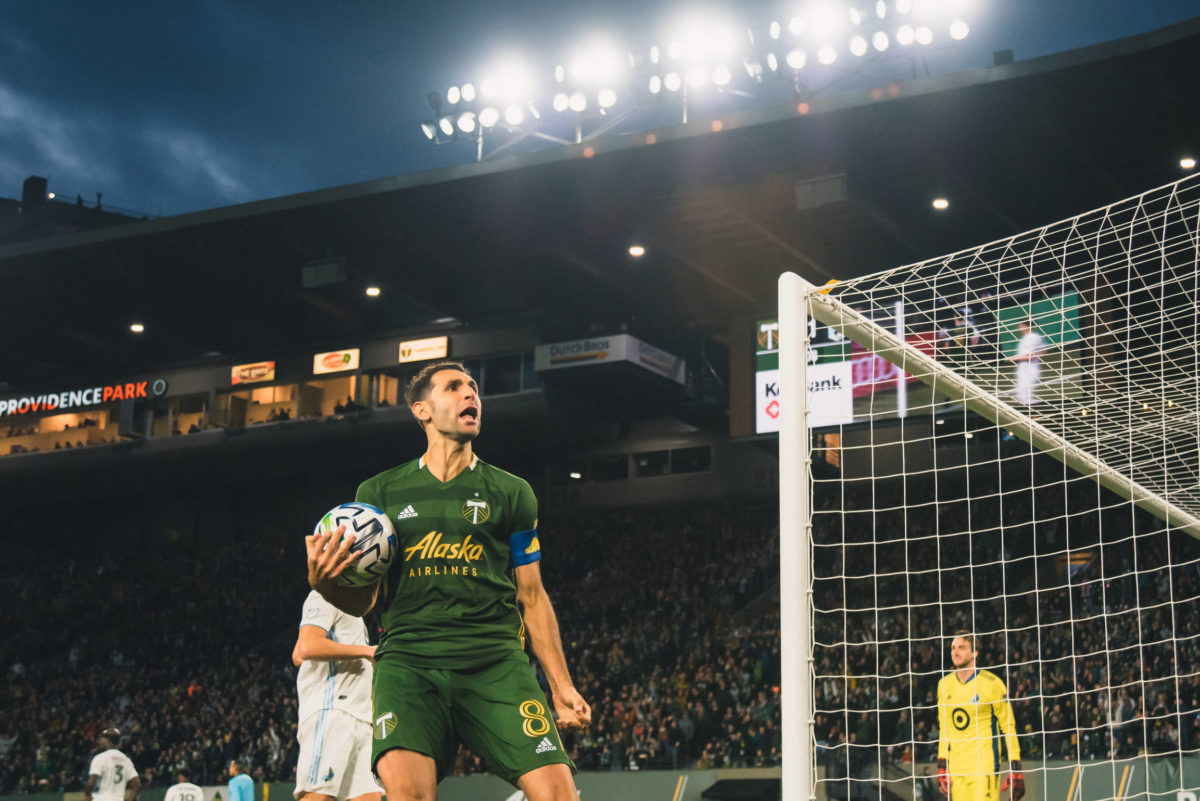
What makes a club good at developing and fostering talent?
It’s a simple question, yet one that seems to have a complex answer. How can a franchise help young, budding talent improve and ultimately thrive at the MLS level and beyond? Is it by having a large scouting network that can unearth talent seemingly anywhere in the world, like New York City FC or New York Red Bulls? Is it consistently giving younger players a majority of the minutes (#playyourkids), a la FC Dallas or Real Salt Lake? Or is it something else?
When it comes to youth development, the Portland Timbers may not be the first club that comes to mind, but what they are good at is establishing an identity that is upheld throughout the organization.
Employing a similar style of play at each level of the organization establishes a consistency for players who often find themselves on the bubble between the first and second teams. While the concept of a team’s tactical identity, top to bottom, is used in a club setting, it’s a more prevalent point of discussion when it comes to the international game. With player movement so much more fluid in, say, the United States player pool, players such as Ulysses Llanez or Giovanni Reyna need to be ready to slide right into the senior side from the youth setup when called upon.
Some coaches prefer every level of the organization to run an identical tactical setup and style while others are more flexible, allowing younger sides to adjust how they play based on personnel or their own established identity. The Timbers want to be somewhere in between.
Like any MLS team, Portland has a defined style of play that holds up from the academy to the MLS side. Over the past few seasons that style has consisted of attacking through wide channels, finding attackers in the box off of crosses, dominating the midfield, and, when the opportunity arises, countering like crazy. With a few minor adjustments based on personnel, that is how Timbers 2 (T2) wants to play as well.
“We strive to mirror what the first team does,” head coach Cameron Knowles said. “I think it’s important that when a first-team player comes to us, the things we’re asking them to do in the game make sense. When a T2 player goes and trains with the first team, they understand their role as it relates to the team.
“…I don’t think we try to deviate too far from that, but obviously, with playing in a league and playing for points, week to week we have to come up with a plan to win a game and that’s where things can differ. In training and a lot of the principles of play, I think there is a lot of consistency from the top-down throughout the club.”
At times, what makes playing similar styles exceptionally difficult is the lack of consistency in the roster. While the first team is afforded the luxury of meticulously planning for the game ahead while adjusting to any tactical wrinkle, T2 often sends players up a level to train while receiving an academy player or two for training themselves. With that being the case, it is imperative for those T2 call-ups to know what to expect at a Savarese practice versus at a Knowles practice.
“The last two years we have been pretty flexible tactically, anyone who watches [the Timbers] will be able to notice that,” Jeremy Ebobisse said when asked about the major tactical differences between T2 and the first-team. “We’ve played a 4-2-3-1, a 4-3-3, a 4-3-2-1, a diamond, two up top. It’s hard to mirror that if you’re the second team. The first team is planning based on personnel and based on the opponent ahead.
He added: “Themes are pretty similar: defend, protect the middle, take advantage of your chances going forward if it’s on the counter or in the build-up phase. It’s largely similar, but how we go about them sometimes is going to differentiate.”
What that means is that, sometimes, a shift in tactics will be necessary to win the game. For example, playing fast and in transition is great, but against a team such as Phoenix Rising or even New Mexico United that can exploit that suddenly available space, it’s not ideal. In games that come down to those pivotal tactical audibles, Knowles will not be afraid to scrap the plan and play directly to his player’s strengths.
“It goes both ways,” Eryk Williamson said. “I know that usually, it’s ‘This is what’s being asked of you, go do this,’ and at the same time [Knowles] is a head coach who wants to win and I really appreciate it.
“…He says ‘I know this is what is being asked of you, but we’re playing Phoenix Rising where now, it’s a habit. We cannot mirror what the first team is doing, now we need to go out and try to win this game.’ That’s a huge part of being flexible as well, it’s not ‘Oh, can I just go out there and personally do well,’ but can you have the right mentality to go out and do well in every game that you play in.”
At the end of the day, having the flexibility to quickly shift tactics is beneficial. But it is also important to monitor how everything comes together on the field. Maintaining those tactical similarities helps with player adjustment and is something that the Timbers and T2 want to accomplish this season, but, if necessary, Knowles is not afraid to change anything up. It will be interesting to see how that plays out as the season progresses.